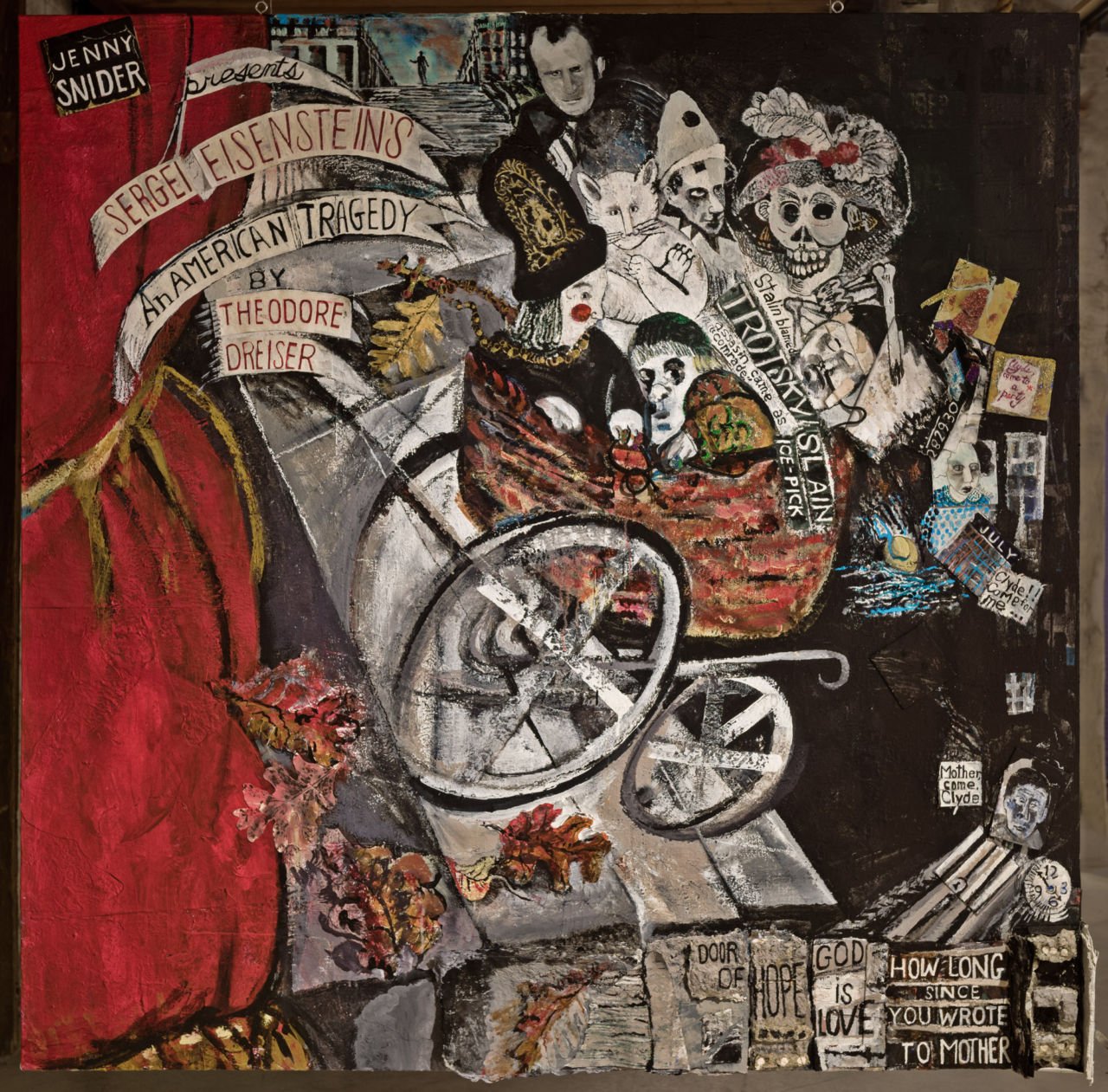Tyrants and Artists: Elliott Green on Jenny Snider
Jenny Snider, Jenny Snider Presents Sergei Eisenstein's AN AMERICAN TRAGEDY by Theodore Dreiser, Very mixed media on canvas, 2013-2017, 6.5 x 6.5 feet
When I first saw a film by Sergei Eisenstein in college, it didn't have a strong effect on me. But in order to understand the iconography of the painting Jenny Snider Presents Sergei Eisenstein's AN AMERICAN TRAGEDY by Theodore Dreiser, I watched Ivan the Terrible, and now it has become one of my favorite movies. The compositions, frame after frame, gripped my attention and landed deep in the mind's eye. For a painter, this is an instructive demonstration of using the right shapes and shadows to conjure story and character (motive and emotion), to visualize the contents of psyche and soul.
Jenny Snider Presents… is composed of three major zones, which are formed and fitted in a structure that I think would find the Master of Cinema’s approval. Read from left to right, it begins with the red theater curtain that anchors the painting and introduces the title, written on white billowing banners. The top one is sickle-shaped, foreshadowing the Worker’s tool as well as a weapon.
The second component is Potemkin’s famous baby carriage careening down the Odessa steps; it is both a vehicle and a metaphorical container, holding five hundred years of Russian and Soviet history, beginning with Ivan the Terrible. And it is poised to topple into an abyss littered with images from the Theodore Dreiser novel, An American Tragedy.
Finally, the An American Tragedy sequence is portrayed along the right side and into the bottom right corner of the composition. It descends, turning left, going backward in the time-space path. Then it projects outward from the rest of the painting surface, becoming three-dimensional in a paper-pulped sculptural relief of the prison cell where Clyde, Dreiser’s pathetic protagonist, waits to be electrocuted. The words “Door of Hope” are written on the dingy face of a wall: It’s over.
During his brief stay in Hollywood in 1930, Eisenstein distilled Dreiser’s 856-page novel into a 132-page screenplay. The story is further edited by Snider to three short notes: “Clyde, come to a party,” “Clyde!! Come for me,” and “Mother, come. Clyde.”
Jenny Snider is an original and natural draftswoman. Since childhood (she's now seventy-three), her hands have trembled from a benign essential tremor. While under control, this gives her drawing lines a gentle vibration, forced/trained not to wander off by her concentration and pressure.
You can feel the tension of steadied energy and patience in the outlines of the clustered heads, which are scaled, edited, fitted, and joined together to form an emotive conglomerate of souls. Her hand-drawn letter forms are distinctive, shaped by an obsessive reworking of the edge, almost like carving, as the background color presses into the lines. This gives the written words a depth of tone that adds expressive force to the language.
Jenny Snider Presents… is a painting that deserves an entire lecture: it is packed full, behind the scenes and out in front. Snider folds in themes of the universal and the personal; sublime imaginations and ruthless assassinations; innocence and malice, idealism and corruption; ego, greed, idiocy, disappointment, vain destruction; the dangerous risk, in some days and places, of the honest truth.
And yet despite the banquet of despair...I find this painting to be thoroughly captivating. For me, it presents an amalgam of beauty and terror, making it a completely fulfilling viewing experience.
Elliott Green, Eternal Now, 2017, Oil on canvas, 36 x 40 inches
Elliott Green was born in Michigan in 1960. He moved to New York City when he was twenty-one and lived there for twenty-four years. In 2005 he moved to Athens, New York, a small town situated between the Catskill Mountains and the Hudson River.


